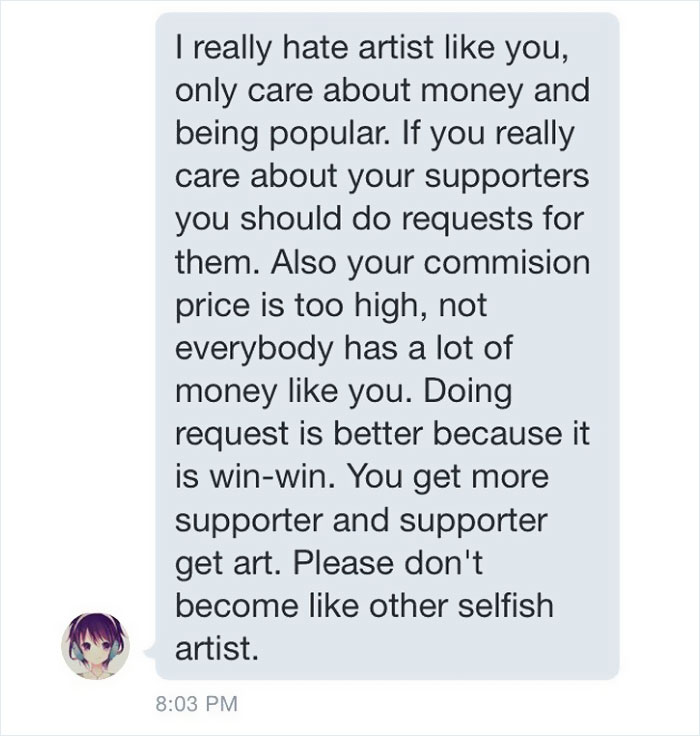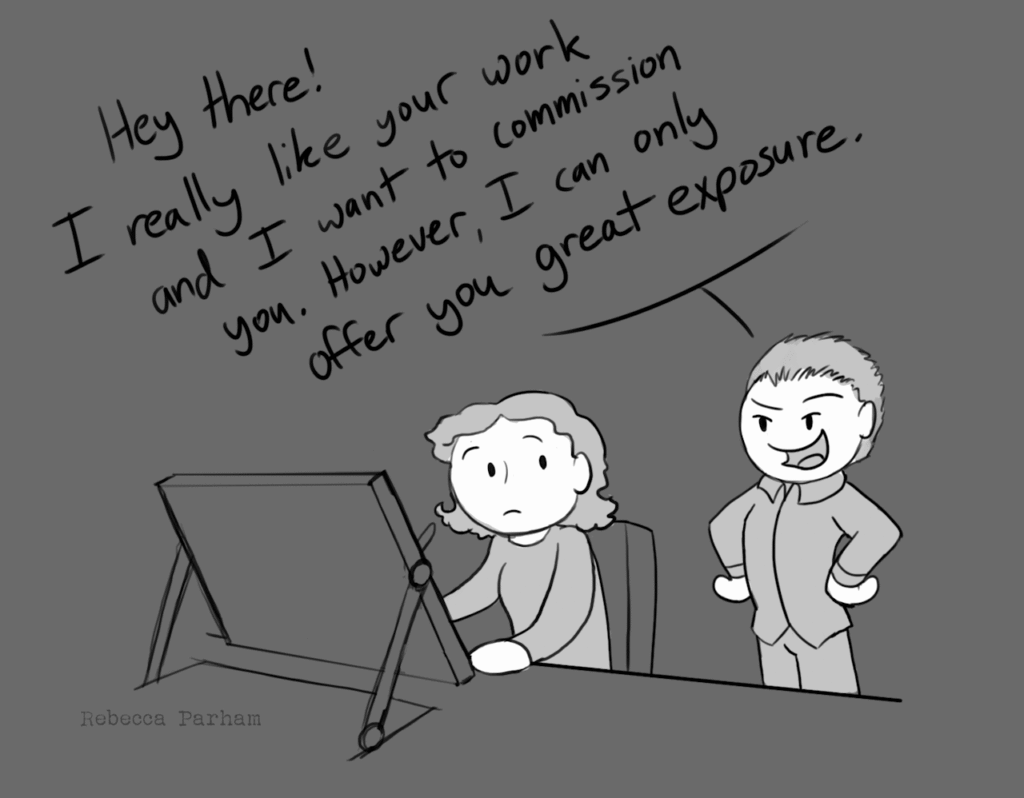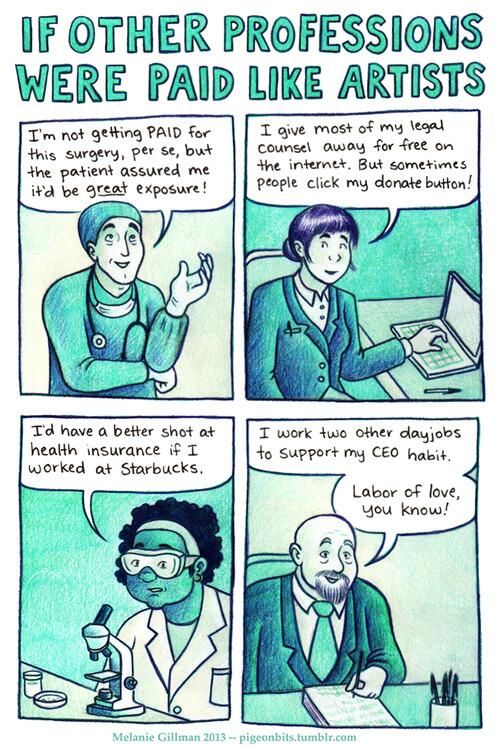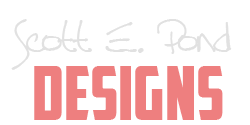Originally published on LinkedIn by Scott E. Pond on January, 8 2015
One of the most common client expectations is great design services for cheap. This is not entirely unreasonable… we all want value for minimal expenditure. For some reason though, many folks will equate your passion for your art and creativity to you being willing to create something for free. Friends, family, acquaintances, and even strangers–everyone seems to think your art should be given for free or for what equates to pocket change. Or, even more interesting, they try to convince you that you should do their project for free “to improve your portfolio”.
I’ve never understood this mentality.
When I was an artist just doing what I do for fun, it didn’t bother me; I loved creating just for the heck of it and if someone wanted something I was happy to accommodate. But as a freelance designer and small business owner, the perspective changed. When you are using your skills to supplement your income or as your sole source of income, it becomes about placing the proper value on your time. When you are relying on your artistic skills for even a portion of your income, every free project that your spend time on takes away from potential money you could be earning with a paid client. So while you may be creating great free designs, you may also be sacrificing more than you realize.
Let’s face it: being a starving struggling artist is great for those with martyr complexes, but for most of us it just plain sucks.

Going hand in hand with your paid versus free creations is the actual value you place on your time. Most beginning artists and designers I know undervalue their time and abilities, effectively working for a couple of dollars an hour. Some of this comes from inexperience and not knowing how long a project would actually take them.
Some actually believe their time and efforts and skills aren’t worth that much.
Let me give you an example:
Way back in 12th grade, I was hired by one of my older co-workers to design the retrospective collectible book for his 30th high school reunion (he was in charge of setting up the whole reunion). This was one of my earliest “high paying” one-shot jobs. I think I made somewhere around $120 for about 30 hours of work, which wasn’t too bad for a 17-year-old (or at least I thought at the time). This one was well before affordable digital design programs, so it was all done by hand. I drew the logos and the cover design. I laid out the text and photos of his classmates with traditional cut outs and glue/tape. The book came in somewhere around 40-50 pages, which he then had professionally copied and bound. It was a huge hit at the reunion, receiving multiple compliments.

On the surface, getting paid $120 for a project was “pretty cool,” especially for a 17-year-old. At first glance, it seemed like a lot of money… but let’s actually evaluate it. I spent 30 hours (or more) on that project. That means at best I earned $4 an hour. Sure, I was young and inexperienced when it came to business sense and appraisal and job estimates. BUT, even at that time I was making over $6 an hour doing a regular, full-time menial (READ: back-breaking) labor job. In my unskilled “real” job, a job anyone who could lift and place 5 pound blocks of sand could do, I was making 50% more than I made doing a project that required a large amount of specialist skills that very few people actually possessed.
Looking back, I was unsure of the actual value of my skills and I thought I’d be crazy to charge more.
Seems a little short-sighted now in hindsight.
For whatever service you provide, you need to determine what your fair market value is for your time and skills. Above all… DO YOUR RESEARCH.
Below are some examples of typical pay ranges for various creative skills (based on the 10% and 90% percentile of pay range):
- Graphic Designer: $12.6 to $37.2 per hour
- Editor: $14.1 to $50.3 per hour
- Writer/Author: $13.3 to $56.6 per hour
- Photographer: $8.4 to $32.2 per hour
- Fine Artists (painters, sculptors, illustrators): $9.3 to $44.7 per hour
- Multimedia Artists and Animators: $16.7 to $54.5 per hour
- General Artist Services: $12 to $48.3 per hour
- Craft Artists (welding, weaving, pottery, needle craft, etc.): $8.5 to $30.4 per hour
- Website Developer: $16.1 to $50.5 per hour
- Musicians/Singers: $8.8 to $65.2 per hour
- Desktop Publisher (page layout): $9.5 to $29.0 per hour
- Audio Voice Talent: $8.3 to $37.8 per hour
*Based on the US Department of Labor, Bureau of Labor Statistics Occupational Employment Statistics, May 2012 (http://www.bls.gov/oes/current/oes_stru.htm#27-0000) and other job-search sources
As you can see, there is a huge variation in pay ranges for each of the specialty services above.
Where you fall into a price point depends on a variety of factors.
- How much actual experience do you have compared to your competition?
- How skilled are you compared to your competition? Do you offer more services or have more abilities in adjacent creative processes than the other creatives in your arena?
- How in demand are you compared to your competition by your existing clients?
- What is your local economic conditions, your personal living expenses, and your overall cost of living?
- What are the economic and budget situation of your average client?
- How much exposure do you have and how many new clients are you connecting with?
The more experienced, in demand, and skilled you are, the more you can–should–charge. In fact, those with higher skills, experience, and a proven track record can even expect potential ranges in salary above those listed above. Your personal market sets your baseline price point.

Conversely, if you are relatively unskilled, are providing services within a large competition pool, or are serving clients with limited funds, you may have to take a lower average hourly rate. In some cases your own economic situation may make being a designer an untenable option. This is the harsh reality… and you need to be willing to evaluate your situation with black and white honesty.
Based on all of these factors, your ideal clients are the ones who can pay your baseline project wage. While you may accept and give breaks to clients who cannot pay your going rate, these tend to rapidly fall out of your “ideal client range”. In many cases, if your prospective clients can’t pay you what you are actually worth, then they are NOT your Ideal Client.
Like in most things, however, there are exceptions to every rule.
For myself, I may charge less than my going rate if the client is new and it’s their first project (I sometimes offer an introductory rate). This greatly depends on whether or not I think they would likely become a long-term client, or if they are more likely to be a one-shot wonder.
Also, you may opt to charge lower rates or even do pro-bona work in order to build up your portfolio. I know, I know. This practice is a double-edged blade; on the one hand, you will often build a repeat client base and improve your portfolio in your given medium rapidly, but at the same token, these clients will come to expect the lower rates unless you are very specific about your pricing strategy. I personally have done this in certain creative projects to build my own experience and to shore up weak portions of my portfolio. It’s an option that has worked for me in the past, but it should be done with a plan in mind, and not as the default.

Lastly, you may offer reduced rates to your repeat clients and charge higher rates to your one-shot clients. This obviously is a strategy to keep and garner trust in your repeat clients and to ensure long-term continued business. By charging them lower rates than what you advertise as your going rates, you make them feel special and they know that they are valued and their business is appreciated.
The bottom line on this is to establish your price range based on your actual value. Trust in yourself and your abilities. Do your research as to the fair market range for your service. If you provide different price points to different clients, that’s ok. Your ideal clients will pay you based on what you are worth and more importantly what you ideally believe you are worth.
If any client is not willing or able to pay your price, even after you apply your targeted pricing exceptions, discounts, and special deals, then YOU PROBABLY DO NOT WANT THAT CLIENT.
Keep looking, and above all, value your skills and abilities properly. If you don’t, chances are others won’t either.
